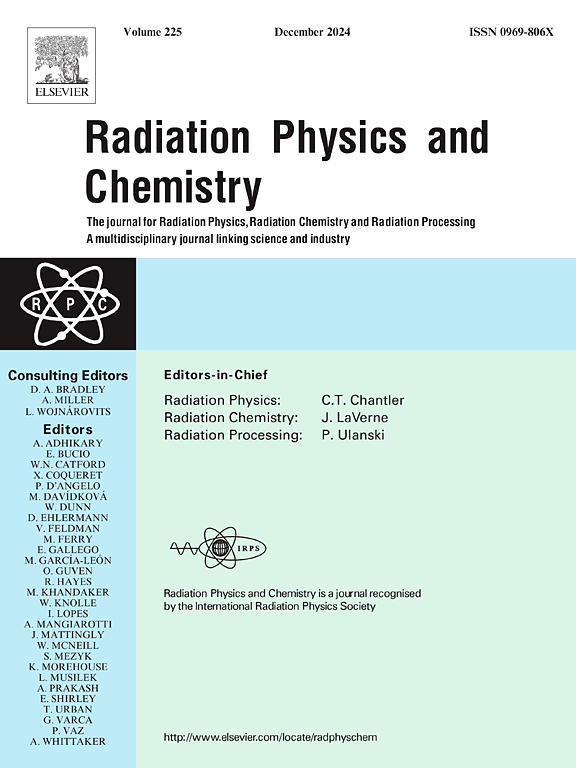Influence of gamma radiation on the structural, optical, and electrical properties of indium tin oxide films with varying thicknesses
IF 2.8
3区 物理与天体物理
Q3 CHEMISTRY, PHYSICAL
引用次数: 0
Abstract
This work explores how gamma radiation affects the optical and electrical behavior of indium tin oxide (ITO) thin films with two different thicknesses, 100 nm and 200 nm. The films were fabricated using DC magnetron sputtering under a constant power of 20 W and then irradiated with gamma rays at doses from 0 to 150 kGy. Structural characteristics were examined by X-ray diffraction (XRD), while surface morphology was studied using field emission scanning electron microscopy (FE-SEM). Optical measurements were performed using a UV-Vis spectrophotometer, and electrical properties were investigated by four-point probe and Hall effect methods. The experimental results indicate that the 200 nm films showed enhanced XRD peak intensity after gamma irradiation, whereas the 100 nm films exhibited a reduction in peak intensity. Both the optical transmittance and energy bandgap decreased as the radiation dose increased. In terms of resistivity, the 100 nm films showed a slight increase at 50 kGy before decreasing at higher doses, while the 200 nm samples presented a consistent increase throughout the dose range. Overall, the findings reflect how film thickness and radiation exposure together influence the physical and electronic characteristics of ITO layers.伽玛辐射对不同厚度氧化铟锡薄膜结构、光学和电学性能的影响
本研究探讨了伽马辐射如何影响两种不同厚度(100nm和200nm)氧化铟锡(ITO)薄膜的光学和电学行为。采用直流磁控溅射技术,在恒定功率20w下制备薄膜,然后用0 ~ 150kgy剂量的伽马射线照射。用x射线衍射(XRD)分析了结构特征,并用场发射扫描电镜(FE-SEM)研究了表面形貌。采用紫外-可见分光光度计进行光学测量,采用四点探针和霍尔效应方法研究电学性能。实验结果表明,辐照后200 nm膜的XRD峰强度增强,而100 nm膜的XRD峰强度减弱。随着辐射剂量的增加,光透过率和能隙均减小。在电阻率方面,100 nm薄膜在50 kGy时略有增加,在更高剂量下下降,而200 nm样品在整个剂量范围内呈一致的增加。总的来说,这些发现反映了薄膜厚度和辐射暴露如何共同影响ITO层的物理和电子特性。
本文章由计算机程序翻译,如有差异,请以英文原文为准。
求助全文
约1分钟内获得全文
求助全文
来源期刊

Radiation Physics and Chemistry
化学-核科学技术
CiteScore
5.60
自引率
17.20%
发文量
574
审稿时长
12 weeks
期刊介绍:
Radiation Physics and Chemistry is a multidisciplinary journal that provides a medium for publication of substantial and original papers, reviews, and short communications which focus on research and developments involving ionizing radiation in radiation physics, radiation chemistry and radiation processing.
The journal aims to publish papers with significance to an international audience, containing substantial novelty and scientific impact. The Editors reserve the rights to reject, with or without external review, papers that do not meet these criteria. This could include papers that are very similar to previous publications, only with changed target substrates, employed materials, analyzed sites and experimental methods, report results without presenting new insights and/or hypothesis testing, or do not focus on the radiation effects.
 求助内容:
求助内容: 应助结果提醒方式:
应助结果提醒方式:


